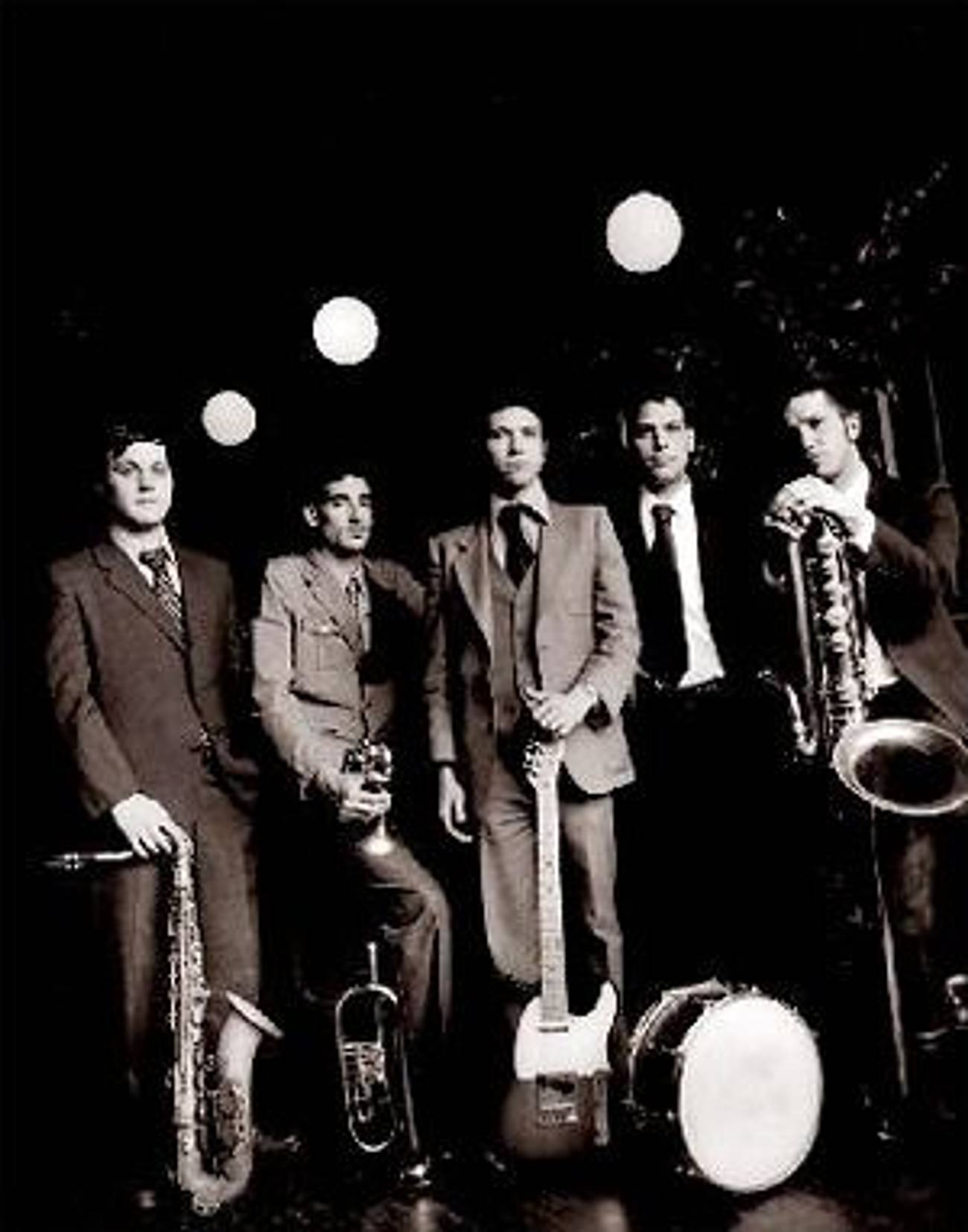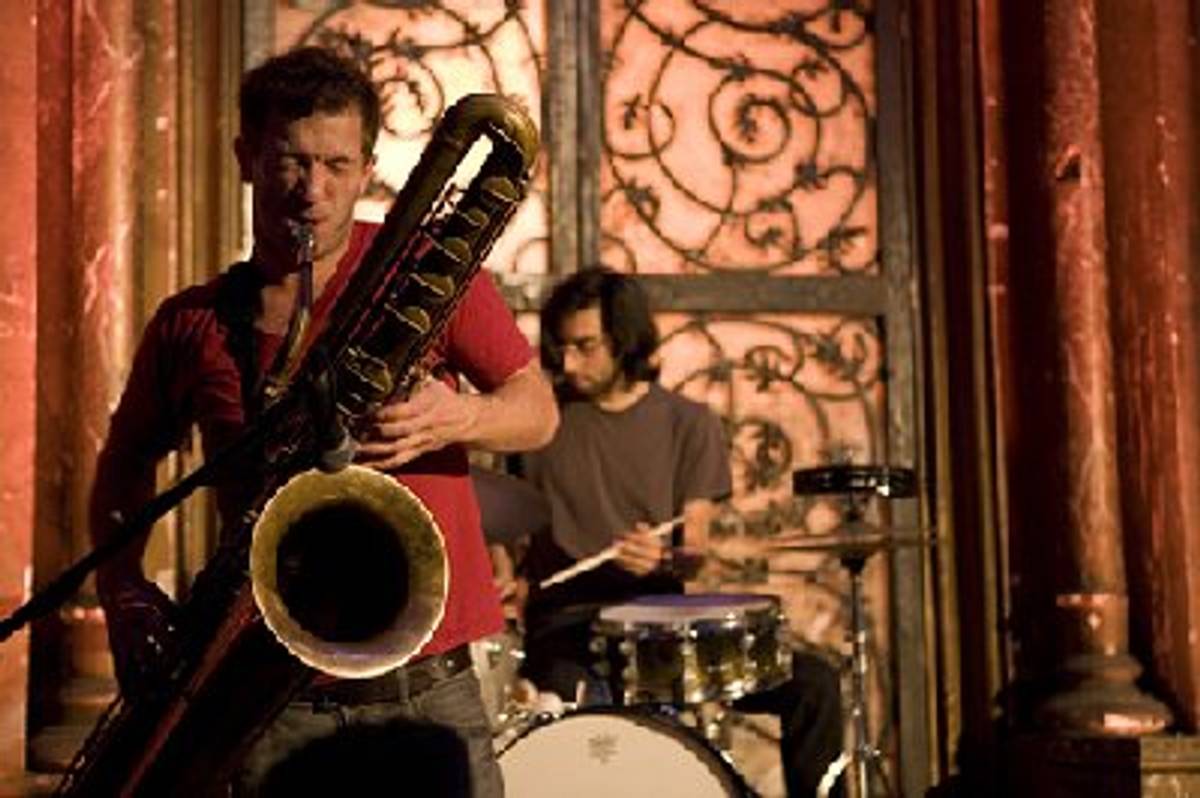Swinging in the New Year
The Sway Machinery party like it’s 5769




Decked out in suits, The Sway Machinery may look formal when they perform, but what they are is focused, in a sort of collective trance. Stuart Bogie, on tenor sax, spends as much time clapping and dancing joyously around the stage as he does blowing his horn. Jordan McLean’s trumpet laces the sound with what he calls “spirit-driven overtones.” As Colin Stetson, bass saxophonist, holds down the low end, his motions appear to waver between dancing and wrestling. Brian Chase snaps the band along from his drum kit. Between tunes, original narrations written and performed by bandleader Jeremiah Lockwood thread the songs together with epic imagery of trials that must be endured.
For Lockwood, these sagas represent Rosh Hashanah’s most salient theme, and it’s one that resonates deeply”no matter the time of year, The Sway Machinery often perform selections from the High Holiday liturgy. “On the New Year it is written who will live and who will die and what our fates will be in the year to come,” he says. “Only three things can avert the harsh decree of heaven: charity, prayer, and penitence … in order to actuate our destinies we must open ourselves on the most core level to feelings of fear, pain, beauty, and transcendence.” Energized by this idea, next Monday and Tuesday, for the second year in a row, Lockwood and his band will put on a Rosh Hashanah multi-media extravaganza; the two-night performance will take place at Le Poisson Rouge in Manhattan’s Greenwhich Village.
History is a driving force behind The Sway Machinery, which, for the past two years, has been devoted to Lockwood’s ongoing “Hidden Melodies Revealed,” a project to revitalize and re-contextualize Ashkenazic cantorial music. According to the project’s mission statement, the group “is unapologetically focused on the rediscovery of self in history and myth.”
Next week’s shows mark the beginning of a new year that is sure to yield many new stories for The Sway Machinery. JDub Records has just released their EP; in late January comes Hidden Melodies Revealed, the band’s first full-length album. In support of the release, the band will tour nationally.
Having grown up with the music of his grandfather, Cantor Jacob Konigsberg, Lockwood has spent his life steeped in traditional Jewish cantorial songs, coming to appreciate how they’ve endured through time and over physical distances. The nomadic roots of these songs inspire Lockwood, resulting in a reverent appreciation for music that transcends any one religion.
No matter your faith, you most likely can’t understand all of the lyrics Lockwood sings, chants, and growls in Hebrew, Yiddish, and Aramaic. But there is something familiar in his arrangements, rich with wailing horns, testifying guitar, and rhythms and cadences borne out of Africa, forced across an ocean and deposited in the New World where they became the blues and jazz.
The band members, all in their early thirties, share plenty of history and have star-studded resumes in common, not to mention a penchant for abstract, whimsical turns of phrase. Lockwood has busked all over his hometown, New York City, carved out a name for himself as a blues musician and singer-songwriter with solo albums, and toured with Balkan Beat Box. Chase also drums in the indie band Yeah Yeah Yeahs, Stetson has toured and recorded with artists ranging from Arcade Fire to Tom Waits, Bogie and McLean perform together in the experimental Antibalas Afrobeat Orchestra. Together, they exalt in what Bogie calls “the straight-up rapture of life crystallized through music.

Last year’s Rosh Hashanah event took place at the Angel Orensanz Foundation, a former synagogue, now an arts center, where Lockwood’s grandfather made his New York City debut in 1949. The 2007 show marked the first time that Chase performed with The Sway Machinery, although it would have been impossible to tell; the experience sold him on becoming part of the band. “The sounds of sacred Jewish music have been with me throughout my life and it is a privilege to work with that material in this new way,” he says. Under the vaulted ceiling in the shadows of grand chandeliers and floral arrangements, the crowd responded ecstatically to the band.
Of the more than five hundred people in attendance, maybe half were Jewish, according to Lockwood’s estimate. Lockwood says his shows appeal even to people who observe Rosh Hashanah in a more conventional manner, many of whom are enchanted by “the concept of creating art by accessing elements of traditional culture.”
Along with music, this year’s event will feature The Akeidah, a short animated film by 2007 Guggenheim Foundation Fellow Shawn Atkins that was also part of last year’s festivities; the shows will also mark the debut of Scenes From a Life of Ben Zion Kapov-Kagan, a nine-minute stop-motion puppet animation film by acclaimed illustrator Andrea Dezso, narrated by the actress Yuli Ya’el Be’eri.
Lockwood commissioned the fictionalized retelling of the life of the Cantor Kapov-Kagan, a real figure whose songs charmed Lockwood by borrowing from non-Western musical traditions and whose biography lends itself to Lockwood’s ideas about the significance of journeys. Kapov-Kagan led a tragic life: he fled the Bolsheviks, leaving his family in Russia behind forever. For Lockwood, Kapov-Kagan’s work and life story evoke “the dynamic of being a great spiritual leader and a broken hobo . . . both an allegory for the journey of the soul over the course of the year, and an attempt to access a place of immediate and almost sentimental emotion.”
Lockwood’s approach to The Sway Machinery is lofty and learned. Although most of the band is not Jewish, and certain religious rites and rituals are lost on them, they feed off Lockwood’s interpretations. As McLean says: “There is no experience like the brain chemistry I am swimming in after finishing a concert with this group.” All five members have played in front of crowds of tens of thousands and know what musical energy can do for the player and the audience. That electricity exhilarates them, regardless of the crowd’s size.
For Stetson, the band’s “closeness makes whatever we do together exciting and important, but he is also motivated by the unique nature of Lockwood’s vision. All the members of The Sway Machinery share a belief in the music’s greater purpose, even if they each express it differently. “We’re reaching back into history and tradition to ground one leg while simultaneously swinging the other leg blindly into people’s hearts and minds,” says Bogie. “We are reading the story and becoming it.”